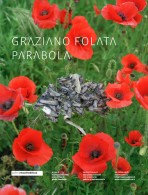

Published on : Monday, January 23, 2017
 Galleria Massimodeluca, the prestigious art gallery in Venice, Italy, will be re-opening for its next exhibition season from February 10 to March 10, 2017. The art gallery’s fifth exhibition season is going to open with the return of the artist Graziano Folata (1982) and the show Parabola, curated by Marina Bastianello.
Galleria Massimodeluca, the prestigious art gallery in Venice, Italy, will be re-opening for its next exhibition season from February 10 to March 10, 2017. The art gallery’s fifth exhibition season is going to open with the return of the artist Graziano Folata (1982) and the show Parabola, curated by Marina Bastianello.
Three years after La pelle della tigre, and to give a sense of continuity to a by-now long-standing collaboration, Folata will exhibit at Massimodeluca a nucleus of previously unseen works, created specifically for the occasion, these once again illustrate the artists’ heterogeneous style which is tied to his unique imagination and experience offering the viewer an exclusive and distinct poetical perception.
“As a result of this show, each member of the public will be able to undergo an authentic transcendental experience”. These are the words of Marina Bastianello, someone who, as the curator of the show, has constantly been in contact with the artist during the time he has spent in the gallery, sharing with him the vision, realisation, and birth of the works.
Giulio Ciavoliello in his critical essay for the show, writes: “Folata, one of the most interesting artists to have appeared on the Italian scene, has with this show pinpointed a further moment of his particular vision of art, easily moving between sculpture, painting, and photography.Different expressive means come together in his search for a harmony that might bring together nature and culture, interior needs, and the totality of the world. Graziano Folata creates meetings between usually disparate elements that come together in the work and ask the viewers to share in the experience, in a participation that leads to mutual understanding. Jellyfish, constantly to be found in his work, are an art material for him. Matched to other elements, they create an impasto useful for generating forms; they also ask the viewers to question themselves about phenomena present in nature, and relate humanity to the evolution of the cosmos. These are organisms consisting almost only of water and, through slow and lengthy desiccation, they become the essence of a form that alludes to the universe. Over the centuries, the hand of man has always created grafts. More than once Folata has grafted together elements that are usually distant and extraneous from each other. His art is made from heterogeneous elements. For example, traditional and solid materials such as marble are brought together with fragile materials such as paper to create a sublime union: a surprising result that is in no way strident. Parabola reserves this kind of surprise for us”.
Tags: art gallery, artist, Culture, elements, exhibition, Galleria Massimodeluca, Graziano Folata, imagination, interior needs, Marina Bastianello, materials, Nature, painting, Parabola, perception, photography, sculpture, style